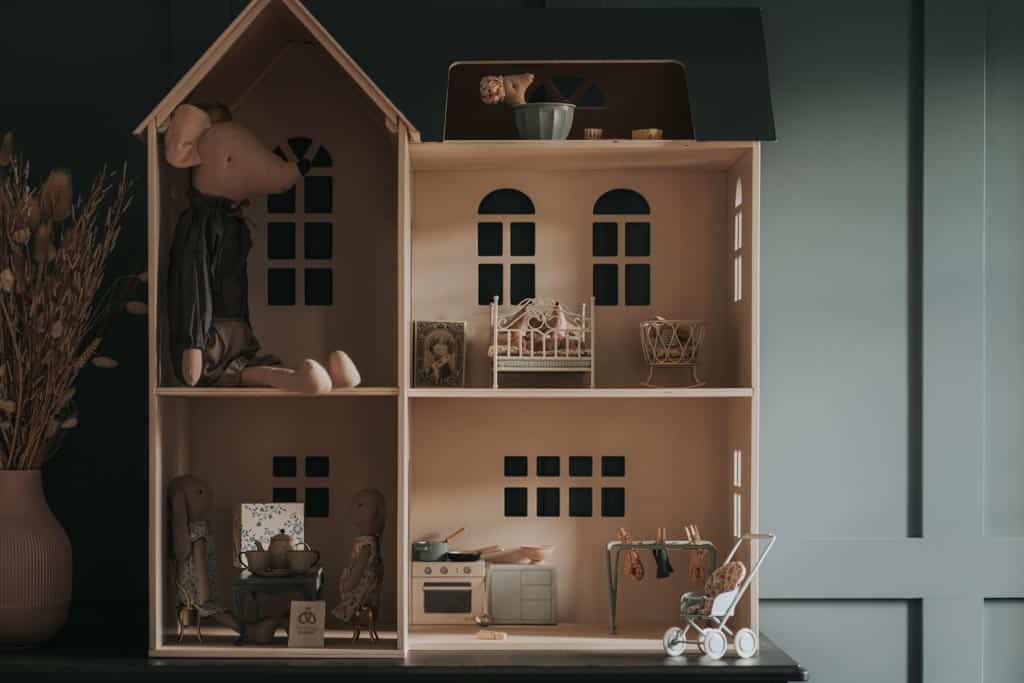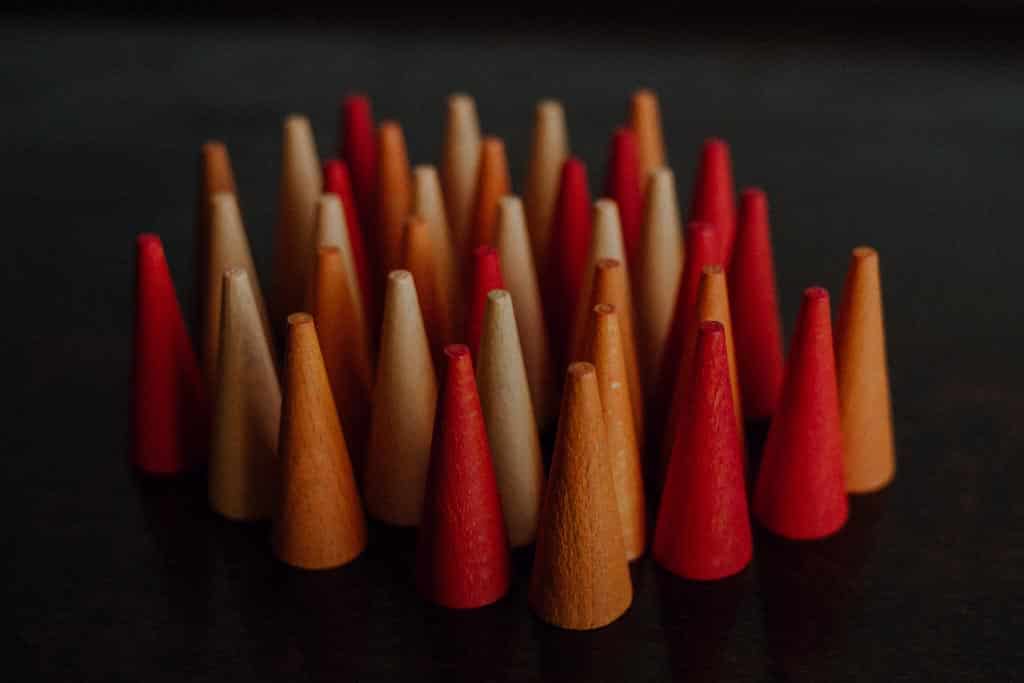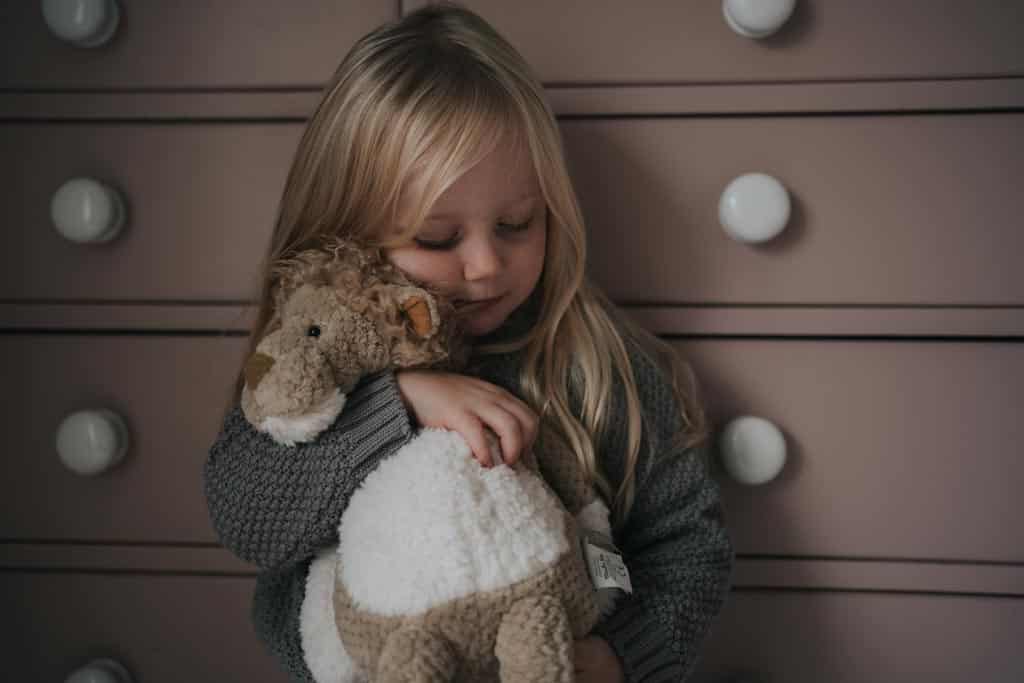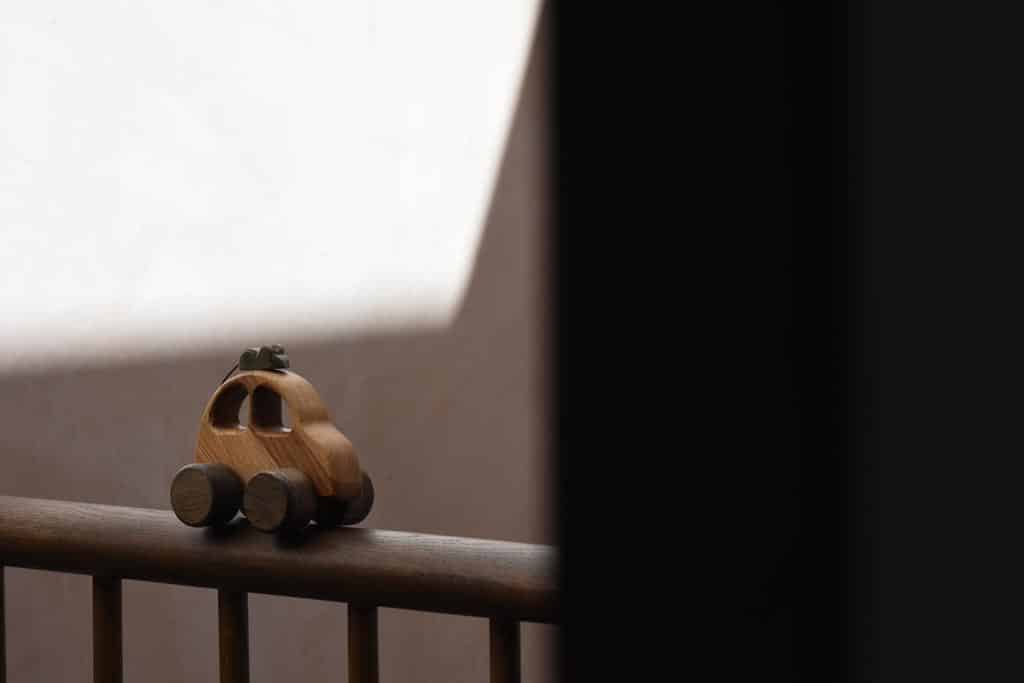What’s so special about playing with doll’s houses? And what’s the secret to their enduring appeal? In this guide we’ll examine the psychology behind children’s play and how it determines which doll’s houses are best.
Discover the psychology of doll’s house play and learn more about why it matters in this guide.
Table of contents
- Introduction
- The benefits of doll’s house play
- The different types of doll’s houses
- Doll’s house furniture
- Choose the right dolls to increase play potential
- Unconventional doll’s houses
- Final word
What are doll’s houses and why are they so important to children?
Doll’s houses have been a fixture in the play world of children for hundreds of years, but it’s reasonable to assume that long before then, children were acting out familiar scenes from their lives using props on a small, child-size scale. Archaeologists have uncovered toy-like figures dating back to pre-history. It’s clearly a primal urge.
Why have these miniature replicas of our homes and other familiar settings become such a staple in our children’s play? Why does a small facsimile of a bedroom suite or a kitchen table fascinate and engage young children so much? And does the traditional doll’s house still have a place in the contemporary world, where our families and lifestyles are changing so rapidly?
The simple explanation is that doll’s houses – whatever their style or configuration – offer children the chance to explore and act out situations and experiences from real life in a safe and inconsequential way. This doesn’t only mean difficult or stressful situations (for example an scolding parent or a scary dog snapping at the heels of the postman), but also exciting or wished-for occurrences (weddings, birthday parties, Christmas) and most often, everyday situations (cooking tea, putting children to bed, watching television by the fire.) Put simply, children use doll’s houses to rehearse for real life, to understand the world they live in, channelling a very basic human instinct to learn and ultimately, survive.
As with all toys, there are doll’s houses and there are doll’s houses. Many of those on offer today have become heavily gendered towards girls, to the point that boys find themselves excluded from, or disinterested in, doll’s house play. And yet given the space and the encouragement to explore doll’s houses, they can be every bit as rewarding, engaging and important for boys.
In this guide we’ll explore the many different types of doll’s houses available and consider the benefits of doll’s house play for boys and girls, and how best to ensure an inclusive approach. We’ll also look at some of the different types of doll’s house furniture and the kinds of figures and families that work best in a doll’s house. And finally we’ll look at ways in which you can extend and develop your child’s doll’s house play over many years.
The benefits of doll’s house play

There are many benefits of playing with a doll’s house for children, from the development of fine-motor skills and ideas of classification and materials, to the growth of social skills and emotional intelligence. A doll’s house can also be one of the most enduring and therefore cost-effective toys you’ll buy, and it’s no coincidence that many of them get handed down through the generations. If you are lucky enough to have received an ‘heirloom’ you can invest in new furniture and figures to bring the house up to date. Here we outline some of the developmental benefits of playing with a doll’s house.
Social skills
A doll’s house is one of the few toys where two children can sit next to each other and play alongside each other, rather than opposite or in some kind of group formation. If it’s a big-ish house there will also be enough in front of them to share without too much need for a dispute about who gets to play with the sofa and who gets the bed. In this way, children can learn to play cooperatively and to become aware of the behaviour of their peers in a fun and simple way. It’s also a great way for ideas and stories to develop without the pressure of a potentially critical gaze on them. If you’ve ever noticed how conversations seem to flourish in the car, it’s the same principles at play; the conversation and exchange of ideas is free to grow. Children who play with doll’s houses together, are often children who know how to share and to rub along with their peers.
Emotional intelligence
Acting out the stories and scenes they encounter in everyday life, allows children to understand the family they live in and the world around them. Even if the ‘family’ in the doll’s house is one of mice or bunnies, children are able to explore characters and personalities via their play figures and the dramas that unfold between them. In doll’s house play, children can weave ordinary elements of everyday life into a fantasy narrative, that they can control. Big themes and powerful thoughts and feelings can be more easily processed on the doll’s house scale, giving this kind of play a therapeutic edge. It also allows children to understand the power dynamics within their family: who is in charge, what the consequences are for bad behaviour. It’s also a chance for children to experience being the adult and telling off misbehaving children. Often their punishments are more extreme and than their parents would ever impose!
We talk a lot about schemas at One Hundred Toys, but there are also schemas for relationships and interactions (and everything else). We’ve all developed mental models for how to react to an angry person, a friendly person, a pet, etc. All this comes from real life experiences and is rehearsed endlessly in doll’s house play. Doll’s houses enable children to pare back interactions to their most basic forms and repeat them endlessly until they understand them.
Spatial reasoning
Without adults or family rules to follow children are free to create their own mess, or order. Arranging furniture, working out that the bed can’t go down the stairs or that the sofa doesn’t fit in the bathroom, is also a way of understanding volume and objects’ relative positions in space. Just because you can squeeze the fridge into the gap behind the kitchen table doesn’t make it usable if there’s no room for the door to open.
Read more about spatial reasoning.

Classification
Understanding what furniture goes where is a form of sorting. Children learn that there are many ways to classify and a doll’s house is the perfect testing ground for their experiments. Should be put all the children in one room and the adults in the other? Do we keep the plates in the kitchen or the dining room? There’s no right answer. What’s important is simply to know that we need criteria to sort by.
Making aesthetic choices
Children learn from us that design is important and they have an innate understanding of beauty and visual harmony. Especially if you go for furniture that is more detailed and lifelike, in a doll’s house there are plenty of textures and materials that reflect those children encounter in real life. The fur rug, the metal bedstead, the curtains in the bedroom; they see the weave of the fabric and the joins in the wallpaper.
Fosters open-ended and imaginative play
There is only one way to complete a puzzle, and once you’ve completed it there’s not much incentive to do it again. A doll’s house, on the other hand, is a completely open-ended toy. There are no rules and play can take any direction it chooses. This is a sized-down version of imaginative or role-play, which because it is contained within the four-walls of the doll’s house, can be left and returned to over and over many times. While your child is downstairs having breakfast, they might be thinking of ways in which to re-enact this meal once they get back to the doll’s house later on.
Fine-motor skills
Fine-motor skills are a key part of engaging in a doll’s house. Placing furniture in the desired positions, posing figures in the correct way and moving them through the spaces in the house, requires delicacy, strength and precision in their hands and grip. If the house has moving parts such as a front that opens out and extras to attach such as fences and garden gates, gross-motor skills come into play as well as hand-eye co-ordination.

How to choose a doll’s house: the different types
With so many different types of doll’s house to choose from, it’s hard to know which one to go for. Whichever doll’s house you choose, we recommend you go for one that has opportunities for figures to move from one space to another. Even a simple one-room house can work if you have a front door that dolls can pass through. Windows to look through are another interesting feature. As well as seeing how figures move about the house, a doll’s house enables children to view things from a different perspective; from the outside in, and of more than one room at a time. They can see the whole story at once – the baby in its cot in the bedroom, the mother in the garden, the brother stealing sweets from the kitchen cupboard. They can see Daddy coming into the kitchen from the living room, about to catch the unsuspecting son in the act of taking the sweets. It’s a kind of interactive picture that they can control. Here we outline the different styles to help you decide which doll’s house is best for your child.
Small and portable doll’s house
You’ll find many contemporary and in particular, Scandinavian doll’s houses, are simplistic and pared back in their style with little or no embellishment or painted colours that might genderise the toy. This type of modern doll’s house gives your child the maximum scope for imagination; it can be a home one day, a hospital or a busy department store the next. And if it’s a portable doll’s house, it’s likely to have a smaller footprint than most, meaning it can come with you on your travels or move easily to different rooms in your home.
Traditional wooden doll’s house
A traditional wooden doll’s house reflects a typical family home in that it has separate rooms and usually more than one storey. (Stairs are often a favourite feature and children love to move their figures up and down.) There’s usually some kind of colour or paintwork on the exterior that suggest traditional features like bricks and window sills, door frame and gates, but ideally this isn’t overly prescriptive or in overtly gendered colours. Furniture, if it’s included, reflects the contemporary home and features modern pieces like a sofa bed in the spare room and a TV in the living room, familiar gadgets like kettles and microwaves in the kitchen.
Grand doll’s house
The grand doll’s house usually has a Victorian look and feel with ornate styling on the outside and three or maybe four levels where family life unfolds. While a palatial residence probably isn’t familiar territory to most of us, it provides an excellent backdrop for fantasy and storytelling. And if your own environment is modest, this type of doll’s house offers the direct opposite: a universe entirely at their command, whether that means simply having a trampoline in the garden or wilder fantasies like having a pet lion in the kitchen. It also means plenty of stairs and children love to move their figures up and down through the different levels, allowing children to really immerse themselves in the traditional routines of family life like putting the children to bed upstairs or holding a a tea party in the dining room. If the front opens up it also makes it a handy storage solution as it’s easy to simply close the doors for the night without needing to alter or adjust the settings inside.
Miniature doll’s house
A miniature doll’s house sits somewhere between a traditional and a portable doll’s house in that is smaller than most but has many of the features of a traditional doll’s house. One of the best features is that it has big windows, creating a sense of space and allowing natural light to shine in on your family and furniture. It is small but still manages to squeeze the most out of the available space, with a cut-out attic and rooms with high ceilings. THis kind of house is especially good for animal play figures like Maileg mice and bunnies, who are less articulated than many regular play figures and therefore have movements and poses that are less intricate. As such it makes a wonderful space for storytelling and can provide a scene for almost any fairytale or bedtime story.
Doll’s house furniture

What kind of furniture should you put in your doll’s house? There are no rules! Many houses come with a set of basic doll’s house furniture supplied. This can be helpful because it means your child can get straight down to the business of play. The furniture will likely reflect the style and form of the house and in that sense will feel familiar and easy to work with.
If you buy doll’s house furniture or get hand-me-downs from friends or relatives, a broad tip is to aim for pieces and accessories that they recognise and that work – a chair with only 3 legs or a wardrobe with no doors will be frustrating and disappointing. The more lifelike details you can incorporate in small items like cutlery, plates, toys and bedding, the more fascinating to them they will be.
But there is also a lot of play value in using non-matching furniture and other non-regulation items your child might find and choose to use in their house. Children are masters at suspending disbelief, so while you might feel that the empty yoghurt pot they are using as a hot tub in the attic doesn’t work with the overall aesthetic, rest assured it is working perfectly for them.
Not all furniture (or, indeed, the figures) has to be to scale. The BBC’s In the Night Garden programme deliberately uses different scales to impart a dreamlike quality to the programme. The Ninky Nonk is tiny when whizzing past the characters but then later is big enough to climb aboard. A doll’s house is no different. Who cares if the bed is too big for the doll or the wardrobe belongs to a much smaller house?
See also Moon and Me, set in a doll’s house with a truly random collection of characters. It definitely wasn’t styled for Instagram! But in the story the characters all get along and co-exist happily. It doesn’t seem strange that the girl lives with a sheep whose eyes are always closed and an onion dressed in trousers.
Choose the right dolls to increase play potential

What are the best play figures for a doll’s house? How many people do you need in a doll’s house? And who should they be?
As you’d expect, the dolls in the doll’s house play a key role in the effectiveness, pleasure and potential of doll’s house play. The family your child has at their fingertips in the house, allows them to explore and experiment with the power dynamics of the world they are growing up in. Who is in charge? What is acceptable and unacceptable? Where do certain members of the family spend most of their time and why? What are your family routines and traditions, beliefs and habits? Life is full of rules and concepts that young children can work through and understand via the people in their doll’s house.
So what are the best play figures to have in a doll’s house? There are no rules, but broadly speaking it is best to have a variety of play figures who can live in your doll’s house; a mix of generations and relationships, rather than say four children. This allows your child to explore the different kinds of interactions (parent and child, parent and parent, siblings, children and pets, visitors to pets etc.) But that doesn’t mean you need an army of dolls. One of each character will be fine, and even just one adult, a child and a dog, will provide more opportunities for diversity of play than three children.
Unconventional doll’s houses
The One Hundred Toys approach is all about less is more; the idea of a doll’s house full of tiny pieces of furniture might seem to be at odds with our ‘fewer, better toys’ philosophy. And we do wholeheartedly believe that anyone can construct their own doll’s house from an old cardboard box or a set of blocks, and we fully encourage you to give making your own a go. But for children there’s something particularly magical about having a realistic-looking building, that you can imagine living in.

Ultimately, a doll’s house is just another kind of small world play. Many of the concepts explored in doll’s house play can be tackled equally well with a wooden castle, a tree house or a garage. Moving up, down, in and out; characters encountering each other and developing relationships. Even a hollow gourd and a couple of peg people is enough to cover the basics – your child’s imagination will do the rest.
But a realistic doll’s house is different. The house stands in for the child’s own home. They can re-enact situations and relationships from their own lives. A doll’s house brings the play to life in a way that’s hard to replicate with a DIY version. And that is what makes a doll’s house so special.
Doll’s houses: a final word
You don’t need a big doll’s house. You’ll get 90% of the play value from a simple one-room house as long as it has windows and a door. Stairs and interconnecting doors are a bonus, as is a closing front. The most important thing is to have enough figures to make it fun and allow for a variety of interactions.
If you think doll’s house play is too mundane and humdrum, take another look. Alongside the humble block there probably isn’t another toy with as much long-term play potential. Children become completely engrossed in their miniature world, and that’s good for them – and good for us too.
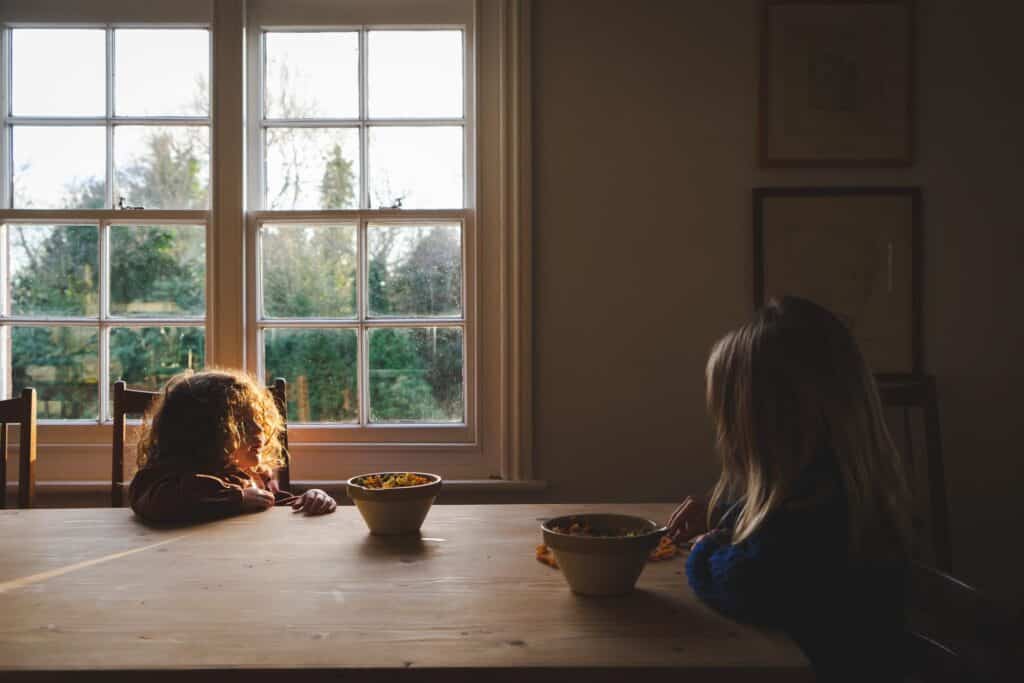
Have you run out of ideas?
What if you didn’t have to trawl the internet for play inspiration? What if your child’s freely-chosen activities were simple to set up, educational and deeply engaging?
How would that change things?
Our courses, A Year With My Child, Get Set Five and 5 Plus are designed for parents of toddlers, preschoolers and the over 5s and they’re packed full of fun and sensible advice.
Enter your email and we’ll send you free modules from each course. And then sit back and relax as your child learns to make her own fun.

